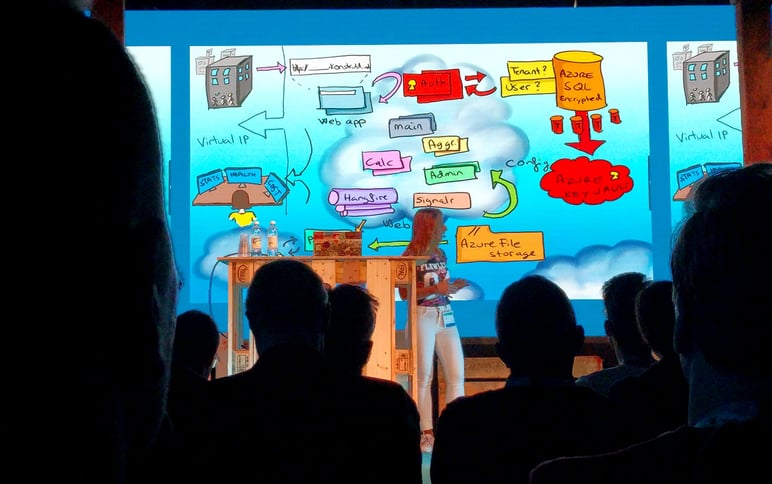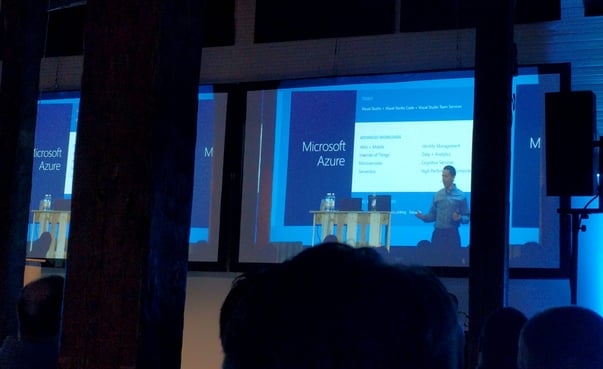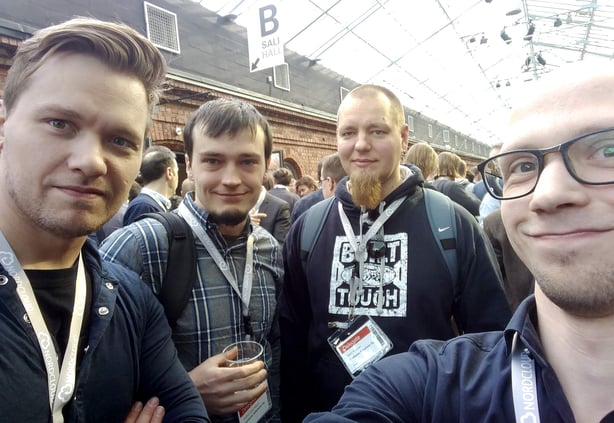 The conference included many expert presentations, such as Iris Classon’s interesting and illustrative presentation on migrating .NET project to .NET Core.
The conference included many expert presentations, such as Iris Classon’s interesting and illustrative presentation on migrating .NET project to .NET Core.
The technology event Microsoft TechDays Finland brings together IT decision makers, developers and IT professionals. The event is focused on new features and efficient use of Microsoft products and services including topical expert presentations. The TechDays Finland conference was organised in Helsinki in Wanha Satama on 21–22 March 2018; the previous event was held in Finland in 2013.
When Pinja’s Dotnet competence team came up with the idea of participating Microsoft’s technology days, the idea was quickly turned into action. We assembled a group of representatives, consisting mainly of developers, and made a deal with our HR director Jaakko: the employer would pay the participation costs provided that the lessons learnt be efficiently shared with all. Fair enough! Sami and Heikki-Jussi set off from Jyväskylä, and Marko and I took a plane from Oulu.
Why TechDays?
The event was of particular interest to me because Microsoft technologies are utilised in several different ways both in my own work and at Pinja in general. .NET framework, SQL Server and other databases and cloud services, such as Microsoft Azure, are keywords in many of our projects and services. The always topical information security, BI analytics and IT environment management, both part of our service offering, were also central elements in the TechDays agenda. In addition, interesting speakers would provide an opportunity to learn about the future and deepen existing knowledge, not to speak of networking with people in the field.
TechDays started on Wednesday morning with James Whittaker’s presentation on the Internet of Things (IoT) and the technological revolution catalysed by Artificial Intelligence (AI). Whittaker gave a nice example of identifying a person in a Jacuzzi bath by chemical means, sensors and artificial intelligence.
Following Whittaker’s address, Sami Laiho gave a presentation on data protection in the Windows environments of organisations. His recommendations included sensible use of the BitLocker and AppLocker tools as part of data protection, using whitelists instead of blacklists. System administrator rights should be used as little as possible and password verification, at the minimum, should always be used for actions performed as the system administrator.

After the opening speeches, our group disassembled each member attending training sessions according to their specific interests. My programme on Wednesday included, for example, future prospects of data visualisation, query language features of the Power BI analytics tool, smart building technology and how to build automated self-service portals in the Office 365 environment.
Thursday started with Jürgen Willis’ presentation on the development of the Azure cloud platform and its range of tools for machine learning, for instance. This was followed by a barnstorming introduction to the state of mind of hackers by Paula Januszkiewicz. She showed some examples of breaking passwords on Windows platforms and also highlighted some data protection areas that organisations should have under control in 2018, which, unfortunately, is often not the case.
What’s next?
To sum up, Microsoft will continue working hard to offer a more diverse Azure platform. Over the last few months, a dozen new services have been released in Azure. Many things that organisations today tailor themselves may soon be available as Azure services; therefore, it is good to keep updated.
Among the newer Azure concepts, Azure’s IoT Hub and IoT Edge were dealt with in the presentations, as well as Azure File Sync, which enables backup of traditional shared drives in the Azure cloud and their synchronisation with multiple locations. Windows Containers were presented as a novelty. Windows based Docker containers can be used in many ways, for example, by establishing them directly in the Kubernetes environment on Azure (AKS).
Regarding technology trends, serverless solutions were also discussed in many presentations. For example, using Azure Functions, it is possible to build the background layer and automation of applications without using dedicated background servers. In the area of artificial intelligence, more straightforward tools are available for the implementation and integration of chat agents or bots. The presentation by Mikael Koskinen and Panu Oksala illustrated how it is possible to control home lightning and room temperature via Slack direct messaging.
Future building technology was illustrated via a research presented by Lucia Loher on smart and responsive buildings. Microsoft has participated in the research as a technology partner. The presentation showed how building data was collected in data channels upon which it was possible to build new services and intelligence; for example, monitoring of actual use of buildings in real time and adapting their heating and cleaning needs accordingly.

Event offering
During the TechDays event, the members of our group participated in a total of 37 different sessions. To my taste, the programme was highly topical, diversified and interesting. Many times, it was difficult to choose between two interesting sessions taking place at the same time, although simultaneity of sessions had been considered in terms of target groups. While some presentations discussed the topics on a more general level, technical hands-on sessions went deep down to code creation or server configuration.
After the event, although we had to quickly get back to daily routines, the resources gained at TechDays were discussed during internal demonstrations. In addition, it will be possible to go deeper to the topics individually or together during Labday learning days. We will possibly return to TechDays topics in the Inside Pinja blog with a more technical approach; as for myself, I would be interested to get my teeth into the use of Windows Containers in Azure.
Tools and platforms are constantly evolving. Things that require time today may be readily available tomorrow and the time saved can be spent on something else. This is why events like TechDays are a good way to maintain knowledge and skills.
Read more
Back to the Pinja Blog
Categories
- Career at Pinja (68)
- Manufacturing (48)
- Knowledge Management (45)
- Production Development (44)
- Software Partnership & Tools (42)
- Sustainability (37)
- Wood and Forestry (37)
- Bioenergy and Recycling (27)
- IT Support and Outsourcing (24)
- Ecommerce (23)
- Maintenance (22)
- Artificial Intelligence and Machine Learning (15)
- Public Services (9)
- Compliance (1)
